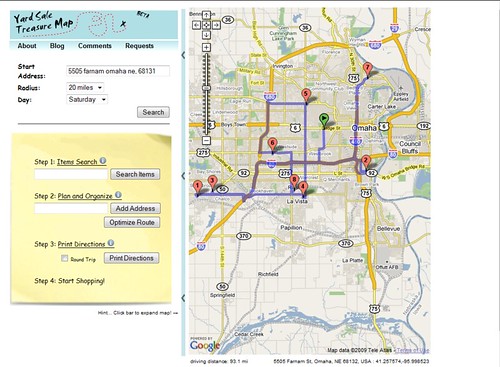Friday, October 30, 2009
Saturday, October 24, 2009
Tuesday, October 13, 2009
US Debt Clock http://www.usdebtclock.org/
US Debt Clock http://www.usdebtclock.org/
en.wikipedia.org/wiki/National_Debt_Clock
National Debt Clock
From Wikipedia, the free encyclopedia:
The National Debt Clock is a billboard-sized running total dot-matrix display which constantly updates to show the current United States public debt and each American family's share of it. It is currently installed on Sixth Avenue (Avenue of the Americas) in Manhattan, New York City.
The idea for the clock came from New York real estate developer Seymour Durst, who wanted to highlight the rising national debt. In 1989, he sponsored the installation of the first clock, which was erected on 42nd Street close to Times Square. At the time, the national debt remained under $3 trillion but was rising. The clock was temporarily switched off from 2000 to 2002 due to the debt actually falling during that period.
In 2004, the original clock was dismantled and replaced by the current clock at the new location one block away. In 2008, the U.S. national debt exceeded $10 trillion for the first time, leading to press reports that the clock had run out of digits. Plans for an upgrade adding to the existing digits have been announced for 2009.
The original clock outlived Seymour who died in 1995, with Seymour's son Douglas taking over responsibility for the clock through the Durst Organization. As of September 2009, Douglas Durst's cousin Jonathan "Jody" Durst, with whom he currently shares a co-presidency of the company, is in the process of taking over the day-to-day operations as president. In an interview with The New York Times, Jonathan Durst has said that maintenance of the clock is planned "for years to come."[1]
History
Invented and sponsored by New York real estate developer Seymour Durst, the National Debt Clock was installed in 1989.[2] After Seymour's death in 1995, his son Douglas Durst became president of the Durst Organization which owns and maintains the clock.[3][4][5]
According to Douglas Durst, his father had been toying with the basic idea of drawing attention to the growing national debt since at least 1980, when during the holiday season he sent cards that said "Happy New Year. Your share of the national debt is $35,000" to senators and congressmen.[6] In the early eighties, when Durst first developed the idea of a constantly updated clock, the technology required to implement the project was not yet available.[7]
Douglas Durst has been quoted as saying that the clock is a non-partisan effort; he has further explained the motivation behind the project in terms of intergenerational equity: "We're a family business. We think generationally, and we don't want to see the next generation crippled by this burden."[7]
[edit] First clock
Nuvola apps kview.png External images
Searchtool.svg The original clock
[8]
With the national debt at 2.7 trillion dollars, the original 11 by 26 feet (3.4 m × 7.9 m) clock was constructed in 1989 at a cost of $100,000.[3] It was erected at Sixth Avenue, a block from Times Square, located on the north side of 42nd Street, easily visible from Bryant Park. Built by the New York sign company Artkraft Strauss, the clock featured a dot-matrix display with the then-typical character resolution of 5x7. Similar to the second clock, the updating mechanism was such that the display was set to the estimated speed of debt growth and adjusted weekly according to the latest numbers published by the United States Treasury.[9][3][5] Up until the week before his death, Seymour Durst himself adjusted the tally via modem.[3] Since his passing, Artkraft Strauss has been keeping the figures current.[3]
In 2000, due to an improving debt situation, the clock started to run backwards.[4] With the original purpose of the clock being to highlight the rising debt and the reverse giving a mixed message, and with the display not being designed to properly run backwards,[7] the clock was unplugged and covered with a red, white and blue curtain in September 2000, with the national debt standing at roughly 5.7 trillion dollars.[5] The clock was not dismantled however, and in July 2002 the curtain was raised and the clock once again picked up tracking a rising debt, starting at 6.1 trillion dollars.[10]
[edit] Second clock
In 2004, the original clock was unmounted from its location at 42nd Street; the building has since made way for One Bryant Park. An updated model, which could run backwards, was installed one block away on a Durst building at 1133 Avenue of the Americas (Sixth Avenue).[11][7] It is mounted on the side wall of the Building which faces W 44th street. The new clock is outfitted with a dot-matrix display of higher resolution than its predecessor, the numbers thereby more closely emulating the customary seven-segment numeral patterns.
In the midst of extensive media attention devoted to the financial crisis of 2007–2008, some news reports again turned to the National Debt Clock as a symbol and metaphor, particularly highlighting the fact that the clock ran out of digits when the gross federal debt rose above $10 trillion on September 30, 2008.[12][13][14]
An overhaul or complete replacement adding two more digits to the clock's display is currently in the planning for 2009.[9][15][16]
[edit] Similar projects
German national debt clock at the Berlin headquarters of taxpayer watchdog group Bund der Steuerzahler
The National Debt Clock is the first of its kind; it has since inspired similar projects elsewhere in the United States, as well as in other countries such as Germany.[3][17] There also exist various debt tracking resources online.
[edit] See also
* Government debt
* United States public debt
* History of the U.S. public debt
* Maxed Out, a 2006 documentary in which the clock is featured[18]
[edit] References
1. ^ Marino, Vivian (September 11, 2009). "Square Feet | The 30-Minute Interview: Jonathan Durst
". The New York Times. www.nytimes.com/2009/09/13/realestate/commercial/13SqFt.html
. Retrieved September 15, 2009.
2. ^ Daniels, Lee A. (November 8, 1991). "Chronicle
". The New York Times. query.nytimes.com/gst/fullpage.html?res=9D0CE5DD163CF93BA...
. Retrieved 2008-10-06.
3. ^ a b c d e f Toy, Vivian S. (May 28, 1995). "The Clockmaker Died, but Not the Debt
". The New York Times. query.nytimes.com/gst/fullpage.html?res=990CE1D61538F93BA...
. Retrieved 2008-10-06.
4. ^ a b "National Debt Clock stops, despite trillions of dollars of red ink
". CNN, AP, Reuters (hosted on Internet Archive's Wayback Machine). September 7, 2000. web.archive.org/web/20080129144855/edition.cnn.com/2000/U...
. Retrieved 2008-10-05.
5. ^ a b c Upham, Ben (May 14, 2000). "NEIGHBORHOOD REPORT: TIMES SQUARE; Debt Clock, Calculating Since '89, Is Retiring Before the Debt Does
". The New York Times. query.nytimes.com/gst/fullpage.html?res=9905E7D8143BF937A...
. Retrieved 2008-10-05.
6. ^ Koh, Eun Lee (August 13, 2000). "FOLLOWING UP; Time's Hands Go Back On National Debt Clock
". query.nytimes.com/gst/fullpage.html?res=9500E1DC133FF930A...
. Retrieved 2008-10-06.
7. ^ a b c d "US debt clock running out of time, space
". China Daily / AFP. 2006-03-30. www.chinadaily.com.cn/world/2006-03/30/content_556588.htm
. Retrieved 2008-10-05.
8. ^ NYC: National Debt Clock
, Flickr Image by user wallyg, taken 28 April 2003, uploaded 24 May 2006, accessed 15 October 2008
9. ^ a b Rubinstein, Dana (October 6, 2008). "Durst To Add Extra Trillion Dollar Digit to National Debt Clock
". observer.com. www.observer.com/2008/arts-culture/debt-clock
. Retrieved 2008-10-08.
10. ^ Stevenson, Robert W. (July 13, 2002). "White House Says It Expects Deficit to Hit $165 Billion
". The New York Times. query.nytimes.com/gst/fullpage.html?res=9506E5D81E30F930A...
. Retrieved 2008-10-06.
11. ^ Haberman, Clyde (March 24, 2006). "We Will Bury You, in Debt
". The New York Times. select.nytimes.com/2006/03/24/nyregion/24nyc.html?scp=16&...
. Retrieved 2008-10-06.
12. ^ "National Debt Clock runs out of digits
". timesonline.co.uk. October 9, 2008. www.timesonline.co.uk/tol/news/world/us_and_americas/arti...
. Retrieved 2008-10-10.
13. ^ "The Debt to the Penny and Who Holds It — Daily History Search Application
". TreasuryDirect. September 30, 2008. www.treasurydirect.gov/NP/BPDLogin?application=np
. Retrieved September 15, 2009.
14. ^ "Debt clock can't keep up (CNN video)
". cnn.com. October 4, 2008. edition.cnn.com/video/#/video/us/2008/10/04/dnt.lemon.nat...
. Retrieved 2008-10-05.
15. ^ Boniello, Kathianne (October 5, 2008). "'1' Big Tick is due for Debt Clock
". nypost.com. www.nypost.com/seven/10052008/news/nationalnews/1_big_tic...
. Retrieved 2008-10-08.
16. ^ "U.S. debt too big for National Debt Clock (MSNBC video)
". Nightly News. msnbc.com. October 7, 2008. www.msnbc.msn.com/id/22425001/vp/27051006#27051006
. Retrieved 2008-10-08.
17. ^ "Debt Clock Moves Next Door to Government
". Deutsche Welle. June 18, 2004. www.dw-world.de/dw/article/0,2144,1239561,00.html
. Retrieved 2008-10-05.
18. ^ "indieWIRE INTERVIEW: James Scurlock, director of "Maxed Out"
". indieWIRE. March 11, 2007. www.indiewire.com/people/2007/03/indiewire_inter_51.html
. Retrieved 2008-10-10.
[edit] External links
Search Wikimedia Commons Wikimedia Commons has media related to: US National Debt Clock
* treasurydirect.gov
— U.S. public debt on TreasuryDirect, a website maintained by the United States Treasury
* brillig.com
— U.S. public debt clock website
* perotcharts.com
— U.S. public debt clock and charts
* usdebtclock.org
— U.S. debt clock in real-time
* debtbombshell.com
— UK national debt clock
* steuerzahler.de
— German national debt clock on the website of taxpayer watchdog group Bund der Steuerzahler
Uploaded by shannonpatrick17 on 13 Oct 09, 6.38PM PDT.
Wednesday, October 7, 2009
Barcode Label Printer - Free Online Barcode Generator
Barcode Label Printer - Free Online Barcode Generator
The new doodle from Google marks the 57th anniversary of the day the first patent was made on the bar code.
Granted to American inventors Norman Joseph Woodland and Bernard Silver three years after it was filed, patent number 2,612,994 was for a pattern of concentric circles, rather than the set of straight lines used today.
en.wikipedia.org/wiki/Barcode
From Wikipedia, the free encyclopedia
A barcode is an optical machine-readable representation of data. Originally, barcodes represented data in the widths (lines) and the spacings of parallel lines, and may be referred to as linear or 1D (1 dimensional) barcodes or symbologies. They also come in patterns of squares, dots, hexagons and other geometric patterns within images termed 2D (2 dimensional) matrix codes or symbologies. Although 2D systems use symbols other than bars, they are generally referred to as barcodes as well.
The first use of barcodes was to label railroad cars, but they were not commercially successful until they were used to automate supermarket checkout systems, a task in which they have become almost universal. Their use has spread to many other roles as well, tasks that are generically referred to as Auto ID Data Capture (AIDC). Other systems are attempting to make inroads in the AIDC market, but the simplicity, universality and low cost of barcodes has limited the role of these other systems. It costs about half a United States cent (US$0.005) to implement a barcode while passive RFID still costs about $0.07 to $0.30 per tag.[1]
Barcodes can be read by optical scanners called barcode readers, or scanned from an image by special software. Scanning software for 2D codes is built-in to or available for many mobile phones, and is especially popular in Japan, India, and Europe.
Uploaded by shannonpatrick17 on 7 Oct 09, 10.04AM PDT. ![]()
by Barcodes Inc
Tuesday, October 6, 2009
Okie Noodling 2, Documentary Film about Hand Fishing Huge Catfish
We return to see how noodling has evolved over the last decade. Revisiting the colorful, original cast and meeting some new and eccentric fishermen on the way. Directed by Bradley Beesley, and shot and co-produced by Alan Novey.
Watch this video on Vimeo. Video created by FieldGuide.
((I really enjoyed the documentary film Okie Noodling, my kids were glued to the tv as well. I'm intrested in seeing the second movie because they revisit some of the same people who were in the first film. Everything you ever wanted to know about "Noodling" and more will be answered by watching the first film and probably the second as well.)) -shannonpatrick17
Yard Sale Treasure Map http://www.yardsaletreasuremap.com/

Yard Sale Treasure Map http://www.yardsaletreasuremap.com/, originally uploaded by shannonpatrick17.
http://lifehacker.com/5207604/yard-sale-treasure-map-plots-out-your-weekend-plundering
Yard Sale Treasure Map Plots Out Your Weekend Plundering
By Jason Fitzpatrick, 8:00 AM on Sat Apr 11 2009, 35,177 views
Yard Sale Treasure Map is a Google Maps mashup designed to help you find and easily get to Craigslist-posted yard sales in your area.
You enter a starting address, a driving radius, and select from Friday, Saturday, or Sunday. Yard Sale Treasure Map then queries Craiglist for your area, and returns a route that will take you to all the yard sales it finds. You can click on the markers for each sale to see additional information about the sale and delete them if you're not interested. You can also add in sales that you find from other sources, like your local paper, by either putting the address in the left sidebar or double clicking on the map to place a new marker. This surprisingly elegant hack is free to use.
Yard Sale Treasure Map [via GeekSugar www.geeksugar.com/3019614]
Uploaded by shannonpatrick17 on 6 Oct 09, 10.42AM PDT.













 My StumbleUpon Page
My StumbleUpon Page
Aye Carumba! Marge Simpson poses for Playboy cover
By DON BABWIN, Associated Press Writer Don Babwin, Associated Press Writer Fri Oct 9, 5:29 pm ET
CHICAGO – Aye Carumba!
Marge Simpson has done something that Homer might not like but will make Bart the proudest kid in his school: She's posed for Playboy magazine.
After more than a half century featuring women like Marilyn Monroe, Cindy Crawford and the Girls of Hooters on its cover, Playboy has for the first time given the spot to a cartoon character.
And the magazine is giving the star of "The Simpsons" the star treatment, complete with a data sheet, an interview and a 2-page centerfold.
The magazine's editorial director, James Jellinek, won't say exactly how much of Marge will show in the November edition that hits newsstands on Oct. 16 — or whether she lets that big pile of blue hair down. But, he said, "It's very, very racy."
But he stressed that the mother of three — the youngest a baby, by the way — has a lot to be proud of.
"She is a stunning example of the cartoon form," he said on Friday at the magazine's headquarters in Chicago, appearing both pleased and surprised at the words coming out of his mouth.
For Playboy, which has seen its circulation slip from 3.15 million to 2.6 million since 2006, putting Marge on the cover was designed to attract younger readers to a magazine where the median age of readers is 35, while not alienating older readers.
"We knew that this would really appeal to the 20-something crowd," said Playboy spokeswoman Theresa Hennessey.
The magazine also hopes to turn the November issue into a collectors' item by featuring Marge, sitting on a chair in the shape of the iconic Playboy bunny, on the cover of only the magazines sold in newsstands. Subscribers get a more traditional model on the cover.
"It's so rare in today's digital age where you have the opportunity to send people to the newsstand to pick something up," Jellinek said.
Playboy even convinced 7-Eleven to carry the magazine in its 1,200 corporate-owned stores, something the company has only done once before in more than 20 years.
"We love Marge," said 7-Eleven spokesman Margaret Chabris.
For those who do collect the magazine — and they're out there — the cover will bring to mind another first for the magazine that occurred in 1971 when a black woman appeared on the cover in exactly the same pose and, like Marge, smiling under an impressive head of hair.
"We knew it was something all of our readers would get a kick out of," said Hennessey.
Jellinek said putting Marge on the cover, while unusual, made perfect sense. For one thing, the cover celebrates the 20th anniversary of the TV show. Further, he said there was an episode in which "Marge bears all," which suggested the at she, or at least the people who drew her, would be comfortable with the Playboy treatment.
Perhaps most important, the idea seemed like a good one to the magazine's founder, Hugh Hefner.
"He's a huge 'Simpsons' fan,' said Jellinek. "He's been on 'The Simpsons.'"
Uploaded by shannonpatrick17 on 13 Oct 09, 7.04PM PDT.